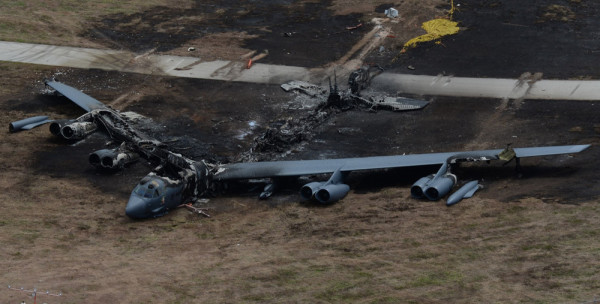

Nearly one year after a B-52H Stratofortress bomber crashed shortly after takeoff at Andersen Air Force Base in Guam, the U.S. Air Force has finally identified the culprit: a flock of goddamn birds.
Well, sort of. An investigation by Air Force Global Strike Command concluded that the crash, which took place during a routine training mission on May 19, 2016, was caused by a mechanical failure during an aborted takeoff, military officials announced Monday. But the initial release by the Accident Investigation Board initially attributed the crash to a “bird sighting,” stating that the pilot had “analyzed visual bird activity and perceived cockpit indications as a loss of symmetric thrust required to safely attain flight.”
Crew members’ accounts of the incident in the full Global Strike Command paint a distinctly more “Miracle on the Hudson” picture. From Air Force Times:
An accident investigation board found that the accident began when the pilot of the B-52 — which was assigned to the 5th Bomb Wing’s 69th Expeditionary Bomb Squadron — saw birds ahead at wing level as the plane was conducting a “high-speed, heavy-weight” takeoff during a routine training mission. The co-pilot then heard and felt a ” ‘couple of thuds’ that sounded like something hitting the aircraft,” the report said.
The pilot and co-pilot then saw three of the plane’s four engines on the right wing “quickly spooling back” and losing thrust necessary to safely get off the ground. The oil pressure spiked on the wing’s fourth engine — which suggested to the pilot that it was also about to fail — and the plane experienced a “noticeable left-to-right yawing motion,” according to the report.
An aborted takeoff is worrying on its own, but this is where things actually got out of control. According to Air Force Times, the B-52’s drag chute failed to inflate, leaving the aircraft to exceed the upper limit of its brakes and skid off the runway. After coming to a halt 300 feet beyond the runway, the fuselage quickly burst into flames, prompting the crew to bail.
Only one of the seven crew members aboard the B-52H suffered minor injuries, but the resulting fire completely destroyed the $112 million aircraft, one of 102 that entered service starting in May 1961. Boeing produced 744 total B-52s for the Pentagon starting in 1955.
Despite the proximity of the bird sighting and “thuds” reported by the co-pilot, the AFGSC report determined that birds likely didn’t actually strike the B-52. The investigation found “no evidence of any organic material being processed through the engine,” so far that “all of the debris found in the engine consisted of pieces of coral, dirt, and grass that was processed through the engines when they contacted the ground.”
“I don’t think they found any evidence, but the plane was burned up,” Global Strike Command spokeswoman Carla Pampe told ABC News, assuring them that the various mechanical issues surrounding the aircraft’s drag chute and brakes “do not indicate any larger issues among the B-52 fleet.” (Good thing the Pentagon’s fleet of Vietnam-era B-52s is slated for a much-needed modernization plan.)
We look forward to watching Clint Eastwood’s film adaptation of the incident.